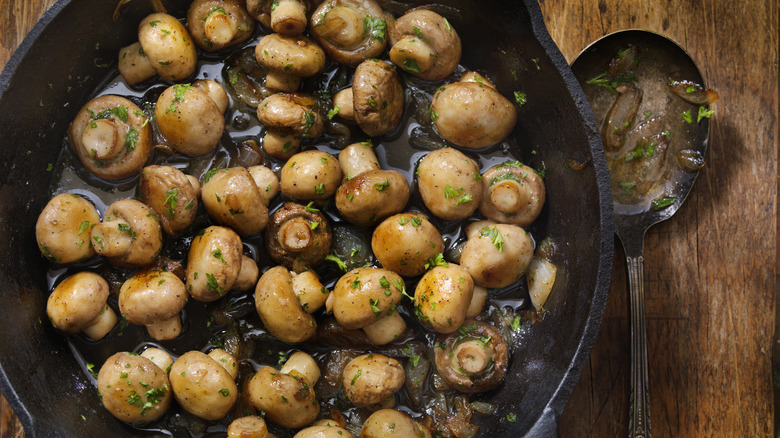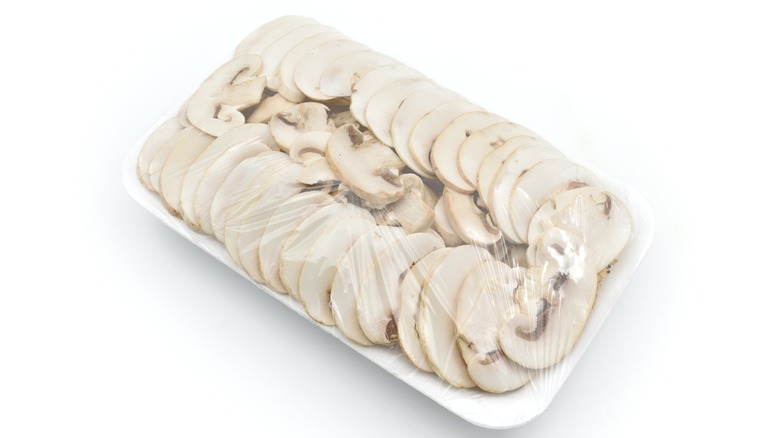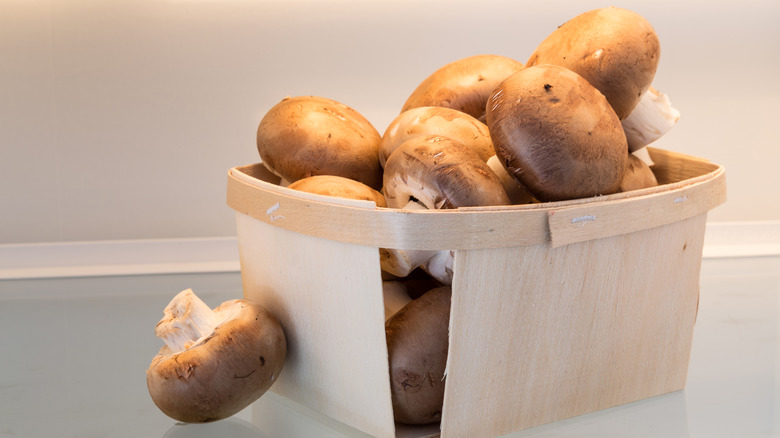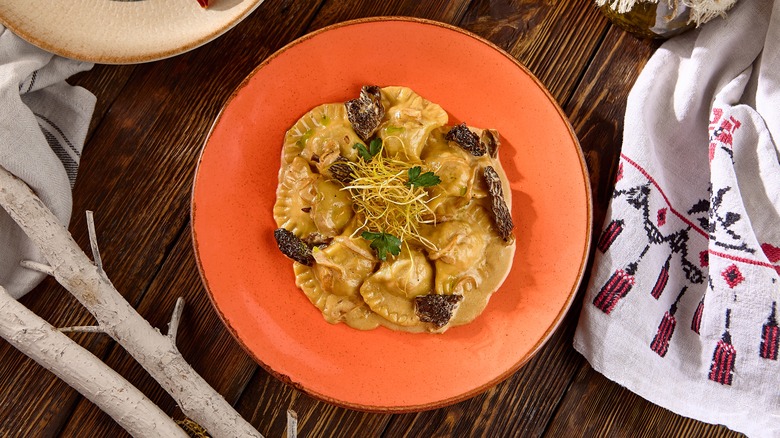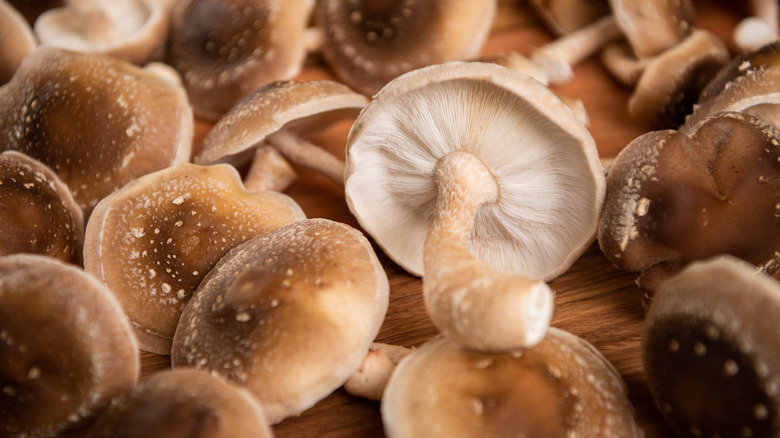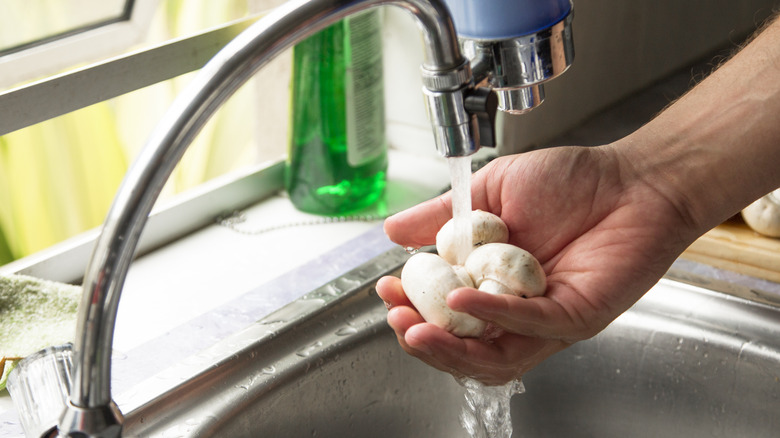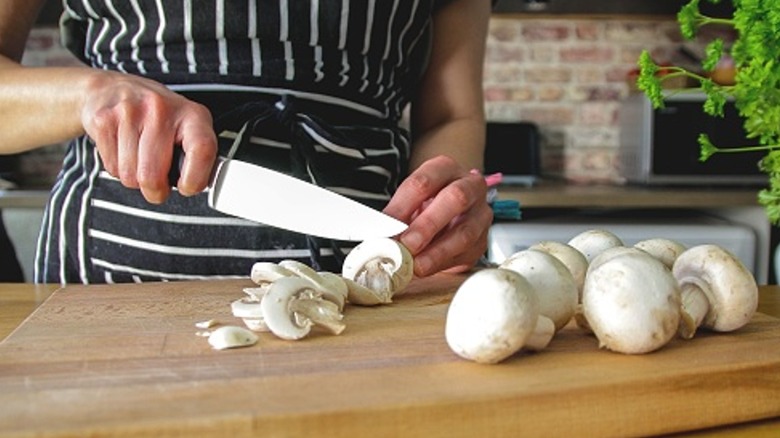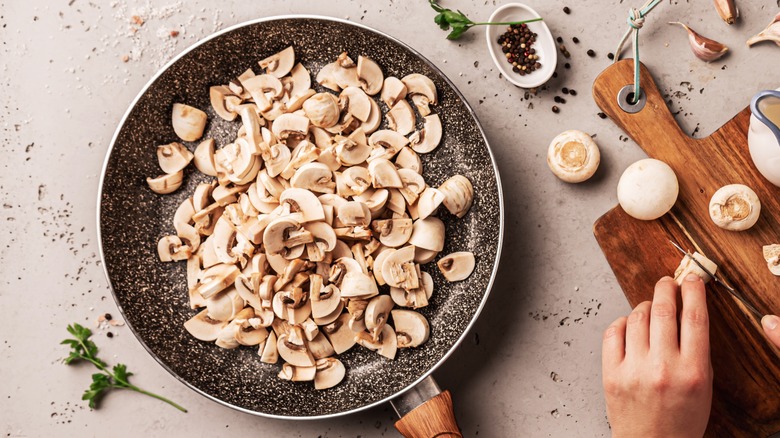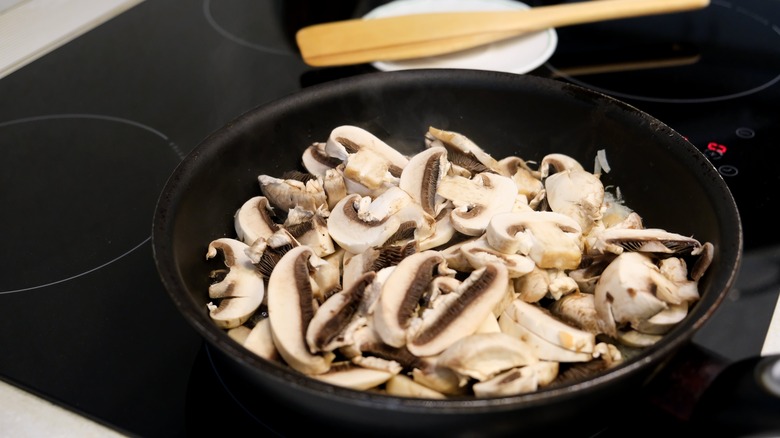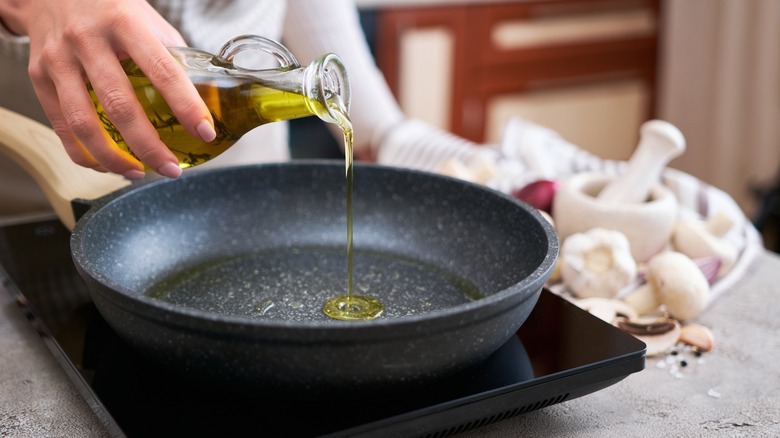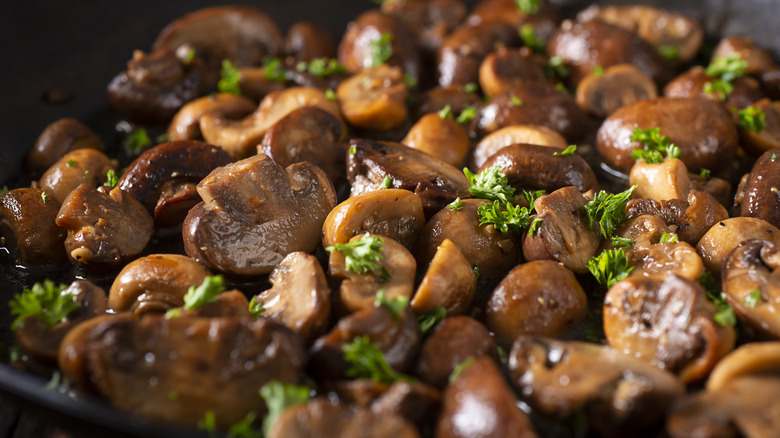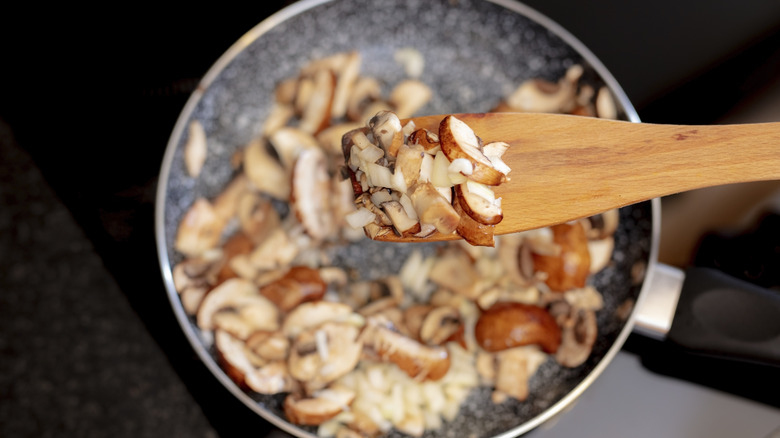Chefs Put A Cap On The Mistakes Ruining Your Mushrooms
We may receive a commission on purchases made from links.
Whether for serious foragers or casual grocery store shoppers, fall seems to be the season when we're all thinking about mushrooms. While the meaty nourishment may have once gotten a bad rap for being soggy, flavorless, or too gray, mushrooms are the food of the future, and we seem to grow fonder of them year after year. Maybe the biggest reason some of us have turned our noses up at funky fungi, however, is because we haven't been cooking them right. Preparing mushrooms isn't tricky business, but we can unknowingly commit lots of mistakes that completely sabotage their flavor.
The most common store-bought mushrooms we incorporate into our cooking are really all the same type, just at different stages of growth, from white button –– the youngest –– to cremini, and portobello. Apart from these familiar varieties, the world of flavorful fungi includes thousands of other types, from morels and chanterelles to wild lobster and king trumpet. Before experimenting with the wilder ones, though, you'll have to learn which mistakes to avoid to get the most flavor and nutrition out of your mushrooms.
We've consulted some experts who know a thing or two about mushrooms, and have given us their go-to methods and tips for preparing this delicious fungi. Find out what chefs Alfredo 'Fredo' Nogueira from Cane and Table, Andy Bruch from Point Easy, Tim Lu from of Michelin-recommended Noisette, and Hunter Evans from Mayflower Café reveal about the biggest cooking mistakes that are ruining your mushrooms.
Buying pre-packaged or pre-sliced
When selecting mushrooms at the store, you might get overwhelmed by seasonal varieties or bins with funky names, leading you to grab the most familiar option: pre-sliced, pre-packaged white button mushrooms. No hate against white buttons, but considering the most interesting fungi won't come pre-sliced, you're limiting yourself from a world of wild and earthy flavors. "Pre-sliced mushrooms are generally inferior in flavor and shelf life," says Noisette executive chef Tim Lu.
Although they're neither fruits nor vegetables, we ought to start treating mushrooms like fresh produce. Just like you wouldn't buy an apple without giving it a quick squeeze, we should first check that our mushrooms are firm and without any bruising. Your biggest concern when buying pre-packaged mushrooms, though, is oxidation and how long they'll last before going bad. Chef Alfredo 'Fredo' Nogueira, Cane and Table, says, "I find the pre-sliced tend to oxidize faster which ultimately shortens the shelf life." Lu adds that the mushroom cell walls will break down just by slicing them — and this action will degrade the mushroom's quality and longevity.
For a more nuanced take, perhaps the mistake isn't buying pre-packaged but rather keeping them in that store packaging at home. "The important thing here is to get them out of that styrofoam container and that plastic wrap and into a situation where they can breathe, [like a] paper bag [or] wire basket with a paper towel," chef Andy Bruch, Point Easy, says. "In fact, here in Colorado quite a few local mushroom growers sell excellent varietals in pre-packaged form."
Incorrectly storing them
You're fighting a losing battle if you try to cook with mushrooms that have gone past their prime. Thanks to their limited window of freshness, that basket of portobello can easily expire if forgotten in the back of the fridge. "It really depends on the mushroom; they're all a little different and in a perfect world would have slightly different storage requirements," Point Easy chef Andy Bruch says, "but for most varieties [they'll last] a week at least if they're stored correctly." When you try out a new varietal, though, that window could be even narrower. "We are lucky to have wild chanterelle mushrooms here in New Orleans and when we get them we process them and hold on to them for only a few days," says chef Alfredo 'Fredo' Nogueira of Cane and Table.
The best way to uphold your fungi's integrity is proper storage habits. "They should be stored as dry as possible, not stacked or squished together, in a porous container so the liquid the mushroom exudes will escape," executive chef Tim Lu recommends. Because moisture isn't good for mushrooms, you're encouraged to store them in a paper bag — a wire basket lined with a dry towel works too.
Keep a close eye on mushrooms in the fridge for signs of spoiling, from discoloration to a shriveled appearance or slimy texture. If you've made the mistake of keeping them around too long, they could end up with an unpleasant –– or even rotten –– taste, and should be discarded.
Using and cooking them interchangeably
With more than 2,000 types of edible mushrooms, you might wonder how each variety really differs from another. If your recipe calls for a unique type, however, your first mistake could be the temptation to swap it for something more familiar. "Some cultivated mushrooms have varying flavors and textures, where you would not really interchange mushrooms (i.e. oyster and maitake)," says executive chef Tim Lu from the Michelin-recommended Noisette.
Nevertheless, the experts reveal that using mushrooms interchangeably is a gray area. Chef Alfredo 'Fredo' Nogueira knows that it really depends on the application of the mushrooms. He says, "I have had some stellar dishes made for me with the simplest white button mushrooms, and similarly you wouldn't want to make a duxelle from something like a morel mushroom." The real mistake may be handling them incorrectly. "Mushrooms are quite versatile," adds chef Hunter Evans of Mayflower Café. "However, since mushrooms vary in size and texture, be mindful of how they cook. If you're using a larger or smaller mushroom than what the recipe calls for, make sure to cut them into appropriately-sized pieces for even cooking." And Lu explains that the texture and flavor of wild mushrooms can vary, along with how you cook them. He adds, "For example, a wild lobster mushroom would need to be braised for a longer period of time than a chanterelle."
As long as you know what you're working with, you could even play around with wilder varieties. "If you were to make a risotto with chanterelles and a risotto with porcini," says chef Andy Bruch from Point Easy, "you'd get two very different (and incredibly tasty) dishes."
Removing the stems
Maybe you thought mushroom stems were something to be discarded the same way you'd leave out long, tough kale stems in your cooking. It turns out that apart from being wasteful, removing the mushroom stalks can rob your dish of additional nutrition and flavor. In fact, they could even be the meal's star ingredient. "Softer stems, like those of cremini or white button mushrooms, can often be cooked and eaten," chef Hunter Evans suggests.
Like most mushroom cooking mistakes, not everything is black or white. Sometimes, the stems are ruining your recipes and distracting from the delicate and delicious mushroom caps. "It depends on the mushroom," executive chef Tim Lu adds. "For a wild chanterelle mushroom, we take off the bottom part of the stem where it is thicker and then peel the woody outside layer off the rest of the stem." Other mushroom stems can be entirely discarded. Evans also says that shiitake mushroom stems should be discarded because they're tough and woody.
The best way to avoid making any mistakes is knowing when to remove the stalk and when to keep it. "For most recipes and preparations, we'll remove the woodiest part of the stem; no one needs to be chewing on those," says chef Andy Bruch. "But for something like a mushroom brodo or duxelle ... we'll use the whole mushroom because it's not noticeable in the end product."
Washing the mushrooms
Search online whether you should wash mushrooms and you probably won't get a definitive answer. "The controversy likely stems from concerns that mushrooms act like sponges, soaking up too much water when washed, which can make them mushy," says chef Hunter Evans from Mayflower Café. Since excess moisture is one of your biggest enemies when perfecting a mushroom dish, you're better off cleaning, not washing, them. "I prefer to clean mushrooms with a pastry brush or wipe them down with a damp paper towel to remove any dirt without soaking them," Evans continues. "After foraging, I'll brush them clean, and for store-bought mushrooms like portobellos, a quick wipe does the trick."
The funkier the fungi, however, the greater chance they'll be dirtier than store-bought varieties. "Certain wild mushrooms come caked in sand and dirt and require a rinse and intricate cleaning of the stems and between the gills, or else they will have an unpleasant grittiness when eating them," chef Tim Lu, Noisette, says.
Chef Alfredo 'Fredo' Nogueira recommends filling a hotel pan with water and dropping the mushrooms in and then transferring them to another hotel pan filled with clean water. "You can do this a few times until the water is clear," he says. "Then I sit them in a large colander to dry before moving them to a towel-lined sheet pan."
Cutting them wrong width
There's no universal standard for how to cut your mushrooms, but that doesn't mean you can't mess it up. Chef Hunter Evans encourages consistency, the slices should be uniform to help ensure even cooking. "The thickness is up to personal preference," he says, "but the thinner you slice them, the crispier they'll get."
Sliced mushrooms work wonders for topping pizza or sautéing with a bit of garlic and oil, but you'll want to avoid slicing them so thick that they don't cook through, or so thin that they burn. Point Easy chef Andy Bruch recommends sticking to a width that's no wider than a #2 pencil. He says, "If you're going to sauté them, that width will hold up when the moisture is lost through cooking and you're less at risk to scorch them." The sweet spot that you don't want to miss out on is the Maillard reaction –– the evaporation and slight browning of the mushrooms that makes their flavors and umami goodness shine.
Mushrooms are also notorious for significantly shrinking in the pan. "I think the mistake that's most common is not using enough mushrooms to begin with to account for the moisture loss," Bruch explains. Consider how to cut the 'shrooms to best suit your recipe: Dicing them into tiny pieces might not be the move for a hearty stew where you want nice, quartered chunks. Likewise, big cubes wouldn't work for a duxelle, where dicing them up is the way to go.
Too many mushrooms in the pan
It may feel only natural to slide your entire pile of mushrooms from the cutting board into the frying pan all at once. But since mushrooms are about 92% water, too many in the pan could end up as something less than desirable. "Overcrowding causes mushrooms to steam instead of sauté," Mayflower Café chef Hunter Evans explains, "preventing them from browning and releasing their natural flavors." Without sufficient breathing room, overcrowded mushrooms will continue reabsorbing all the liquid in the pan, complicating the Maillard reaction and risking their full sweet and earthy potential.
Chef Tim Lu, Noisette, explains that overcrowding the pan lowers its temperature — and this will result in soggy, limp mushrooms. Although it's sometimes a struggle for last-minute weeknight dinners, mushrooms don't like to be rushed. "The biggest mistakes are not being patient and overcrowding the pan," Evans says. He advises to cook mushrooms in batches which will give them an even, consistent browning.
Cooking them on low heat
When asked about the best ways to sauté mushrooms, our chefs were pretty much unanimous: High heat is the way to go. "I like to sauté on high heat with some aromatics and deglaze with a dry white wine such as muscadet," chef Tim Lu explains.
As moisture-dense as they are, you're not getting the most out of your mushrooms (literally) if you leave them on a low-heat burner. "Cooking on low heat won't necessarily ruin mushrooms, but you risk them absorbing oil rather than sautéing properly," says chef Hunter Evans. "High heat ensures the mushrooms brown and release their moisture without becoming soggy." To avoid the dreaded mushy end result, you could invest in a stainless steel pan that can better maintain high heat, or increase the temperature accordingly throughout cooking. "When cooking mushrooms, they exude their moisture," says Lu, "which lowers the temperature of the pan which means it takes longer for the liquid to evaporate." You should be able to hear a healthy sizzling throughout their entire sautéing process. If you're worried about scorching the mushrooms, fear not: Mushrooms can withstand lots of high heat.
Adding butter or oil at the wrong time
When it comes to sautéing, mushrooms are kind of like an all-in-one package –– with enough heat and time they'll brown beautifully in their own juices, eliminating the need for additional fats and making for a healthier meal. While a little oil or butter can seriously boost their flavor, these fats can't be added haphazardly. "You should use a fat that has a high smoke point, such as grapeseed oil, avocado oil, or clarified butter as you want your pan to be extremely hot and the fat to be at smoke point ... [which] keeps the mushrooms from sticking in the pan," Noisette chef Tim Lu recommends. "Olive oil and regular butter will not be able to withstand the high heat without becoming too bitter, or burning."
If you add your fungi to the pan before the oil is smoking hot, it could muddle the cooking process, or end up in overly greasy mushrooms. Chef Andy Bruch, Point Easy, explains that you can add fat to the pan while it's heating — but wait to add the mushrooms until the oil is rippling from the heat.
Although you shouldn't start sautéing mushrooms in butter, there's still time to absorb some later on. "Start with oil in a pan," says chef Hunter Evans, "Be patient –– let them brown before stirring. Once they start to develop color, add garlic and thyme, then finish with butter to deepen the flavor and enhance browning until they're golden and delicious."
Seasoning too early
Once your mushrooms are sizzling on high heat, you should avoid seasoning or adding spices at random, for risk of spoiling your dish. Chef Tim Lu, Noisette, urges you to season mushrooms nearing the end of the final product. He says, "If you season to taste too early, the liquid will continue to evaporate and you will end up with a product that is too salty." Chef Alfredo 'Fredo' Nogueira of Cane and Table echoes the idea, "I find it best to hit them after they have cooked a little and have released the surface moisture."
While it can be harder to judge how much salt will remain in the pan if you season too early, other experts recommend seasoning first, but holding off on the spices. "I like to add salt and pepper almost immediately when I'm sautéing mushrooms," chef Andy Bruch suggests. "Other spices which might have the tendency to scorch would need to be added once you drop your heat." Just be aware that adding salt early will release more liquid, lowering the pan's temperature and requiring a higher heat to avoid any mushy end results.
When it comes to seasoning, mushrooms already boast earthy and meaty flavors that don't need to be drowned out by too many spices. Keep it simple –– a dash of cayenne pepper for a bit of heat, or a sprinkle of parsley for some sweet fragrance.
Undercooking them
Perhaps the biggest mistake you can commit with mushrooms is not fully cooking them. While they're generally pretty forgiving and can turn out great using various techniques, an undercooked mushroom will be watery, rubbery, and lack any exceptional flavor. "Properly cooked mushrooms are golden brown and slightly crispy around the edges, with a deep umami flavor," Mayflower Café chef Hunter Evans explains.
What does an undercooked mushroom look like, then? Chef Andy Bruch it doesn't look like much. "Your nose will tell you when they're done cooking," he says, "and if you're not sure you can always give them a poke for texture while you're cooking them." If the fungi feels like rubber, is still releasing moisture, or hasn't filled the kitchen with the subtle smells of caramelization, give them more time on the heat.
And if you're worried you'll overcook them, thanks to a substance called chitin in their cell walls, mushrooms are incredibly heat-stable. America's Test Kitchen tried out the theory, steaming the cap of a portobello mushroom alongside a piece of zucchini and beef tenderloin. After 45 minutes, while the beef had dried out and the zucchini was mush, the mushroom retained both its moisture and texture. So, when in doubt, leave those fungi to cook a few minutes longer.
